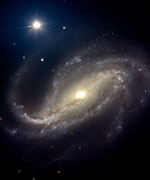
Image credit: ESO
The European Southern Observatory has released three new images of distant spiral galaxies, which were taken while astronomers were searching for quasars. NGC 613 is a beautiful barred spiral galaxy in the southern constellation of Sculptor; NGC 1792 is a starburst spiral galaxy located in the southern constellation of Columba; and NGC 3627 is also known as Messier 66 and located in the constellation Leo.
Not so long ago, the real nature of the “spiral nebulae”, spiral-shaped objects observed in the sky through telescopes, was still unknown. This long-standing issue was finally settled in 1924 when the famous American astronomer Edwin Hubble provided conclusive evidence that they are located outside our own galaxy and are in fact “island universes” of their own.
Nowadays, we know that the Milky Way is just one of billions of galaxies in the Universe. They come in vastly different shapes – spiral, elliptical, irregular – and many of them are simply beautiful, especially the spiral ones.
Astronomers Mark Neeser from the Universit?ts-Sternwarte M?nchen (Germany) and Peter Barthel from the Kapteyn Institute in Groningen (The Netherlands) were clearly not insensitive to this when they obtained images of three beautiful spiral galaxies with ESO’s Very Large Telescope (VLT). They did this in twilight during the early morning when they had to stop their normal observing programme, searching for very distant and faint quasars.
The resulting colour images (ESO PR Photos 33a-c/03) were produced by combining several CCD images in three different wavebands from the FORS multi-mode instruments.
The three galaxies are known as NGC 613, NGC 1792 and NGC 3627. They are characterized by strong far-infrared, as well as radio emission, indicative of substantial ongoing star-formation activity. Indeed, these images all display prominent dust as well as features related to young stars, clear signs of intensive star-formation.
NGC 613
NGC 613 is a beautiful barred spiral galaxy in the southern constellation Sculptor. This galaxy is inclined by 32 degrees and, contrary to most barred spirals, has many arms that give it a tentacular appearance.
Prominent dust lanes are visible along the large-scale bar. Extensive star-formation occurs in this area, at the ends of the bar, and also in the nuclear regions of the galaxy. The gas at the centre, as well as the radio properties are indicative of the presence of a massive black hole in the centre of NGC 613.
NGC 1792
NGC 1792 is located in the southern constellation Columba (The Dove) – almost on the border with the constellation Caelum (The Graving Tool) – and is a so-called starburst spiral galaxy. Its optical appearance is quite chaotic, due to the patchy distribution of dust throughout the disc of this galaxy. It is very rich in neutral hydrogen gas – fuel for the formation of new stars – and is indeed rapidly forming such stars. The galaxy is characterized by unusually luminous far-infrared radiation; this is due to dust heated by young stars.
M 66 (NGC 3627)
The third galaxy is NGC 3627, also known as Messier 66, i.e. it is the 66th object in the famous catalogue of nebulae by French astronomer Charles Messier (1730 – 1817). It is located in the constellation Leo (The Lion).
NGC 3627 is a beautiful spiral with a well-developed central bulge. It also displays large-scale dust lanes. Many regions of warm hydrogen gas are seen throughout the disc of this galaxy. The latter regions are being ionised by radiation from clusters of newborn stars. Very active star-formation is most likely also occurring in the nuclear regions of NGC 3627.
The galaxy forms, together with its neighbours M 65 and NGC 3628, the so-called “Leo Triplet”; they are located at a distance of about 35 million light-years. M 66 is the largest of the three. Its spiral arms appear distorted and displaced above the main plane of the galaxy. The asymmetric appearance is most likely due to gravitational interaction with its neighbours.
Original Source: ESO News Release
